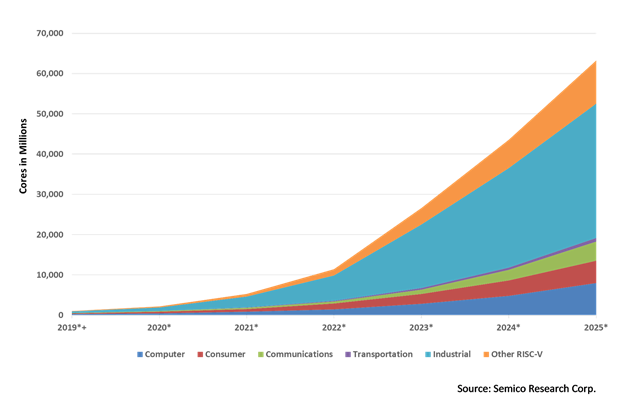Is RISC-V the future? This is a question that we often get asked, and let’s assume that we mean ‘is RISC-V going to be the dominant ISA in the processor market?’. This is certainly an unfolding situation and has changed significantly in the last five years.
What is RISC-V and what does RISC-V do?
RISC-V originated at the University of California, Berkeley, in 2010 and took a number of years to get traction with industry. A big step forward was the formation of the RISC-V Foundation in 2015 as a non-profit organization to drive the adoption of RISC-V. In early 2020, the RISC-V Foundation activity was re-branded and re-incorporated as the Swiss-based RISC-V International.
I remember exhibiting at Embedded World in 2017 and the Codasip stand had the RISC-V logo prominently displayed. Many visitors asked, “what is RISC-V?”, showing that awareness in Europe was low. Since then, the situation has changed dramatically with a high level of interest in all geographies.
For many years, we have tended to classify processors into silos such as MPU, MCU, GPU, APU, DSP, etc. Some devices, such as mobile phones, would combine multiple types of processor cores in their designs. If we think back to, say, 2016, the MPU world was dominated by the X86 architecture while Arm dominated both APUs (application processors and the mobile phone ecosystem generally) and MCUs.
Is RISC-V better than Arm? Is RISC-V better than x86 from Intel/AMD? It definitely is different and brings new opportunities. Today we can identify a few new trends in the market that RISC-V is enabling. Let’s look at 3 of them.
Trend 1: RISC-V is shifting up in performance
In the early years of RISC-V, it was mainly used on academic projects. However, by 2016 a wide range of commercial companies were developing embedded microcontrollers based on the RISC-V ISA. It could be argued that this was a relatively easy step for the RISC-V community, given that embedded developers are used to building their systems from a variety of sources, including middleware delivered as source code. Also embedded cores are simpler in complexity.

What is more challenging is moving into application processors, with considerably more complexity required to support rich operating systems such as Linux or Android. In the case of mobile phone applications, there is a complex ecosystem which will take a while for RISC-V vendors to support. Nevertheless, there are plenty of other opportunities for RISC-V application processors in systems which use Linux, and there is a choice of IP cores such as Codasip’s A70 addressing mid-range performance.
Finally, we can expect more and more suppliers to create complex RISC-V cores for high-performance computing in the future.
Trend 2: RISC-V is breaking down the barriers between processor types
With semiconductor scaling failing, the boundaries between traditional processor grouping are blurring. With more and more demand for domain specific accelerators to achieve cost-effective performance on-chip, it is more and more necessary to tune the design to the needs of the workload required.
With the RISC-V ISA, having a minimalist base integer instruction set and providing for custom extensions, it is an ideal starting point for creating special accelerators.
While some applications, such as mobile phones, with complex legacy software are unlikely to change architecture in the short term, others have no constraints. New applications, such as AI (artificial intelligence), are moving to RISC-V as the open ISA with flexibility and customization. And in a more distant future, RISC-V has the potential to gain even greater market share as legacy considerations cease to apply.
Trend 3: Customers want to avoid a monopoly supplier
Finally, there is a strong desire for change in the processor market. Since the 1980s, microprocessors have been dominated by the Intel/AMD X86 duopoly, but in the late 1990s, Arm became the de-facto standard in the mobile phone processor market. That monopoly extended further into adjacent areas, including embedded.
For the last decade, I have often heard engineers talk of “Arm fatigue” and disquiet with the monopolist position and vendor lock-in in key markets. However, as long as Arm could claim ‘Swiss neutrality’ with their broad product range, nobody would be fired for licensing Arm. With their acquisition by SoftBank, that neutrality was seriously eroded, and the now failed Nvidia merger attempt unsettled many licensees.
The free and open RISC-V ISA has seen widespread interest and is likely to be a catalyst for a sea change in the market. As an open standard, it has the potential to be relevant for decades, and with multiple suppliers offering processor cores, it avoids vendor lock-in.

While nobody expects architectures with a rich history – such as X86 or Arm – to disappear overnight, for the first time in decades designers have a viable alternative in RISC-V. With RISC-V covering a greater and greater range of performance and having a rapidly expanding ecosystem, the market share for RISC-V will continue to grow. This is reflected by market reports such as Semico Research, predicting that the market will consume 62.4 billion RISC-V CPU cores by 2025.
RISC-V surely has a rapidly growing future and a great chance of being a dominant architecture.
